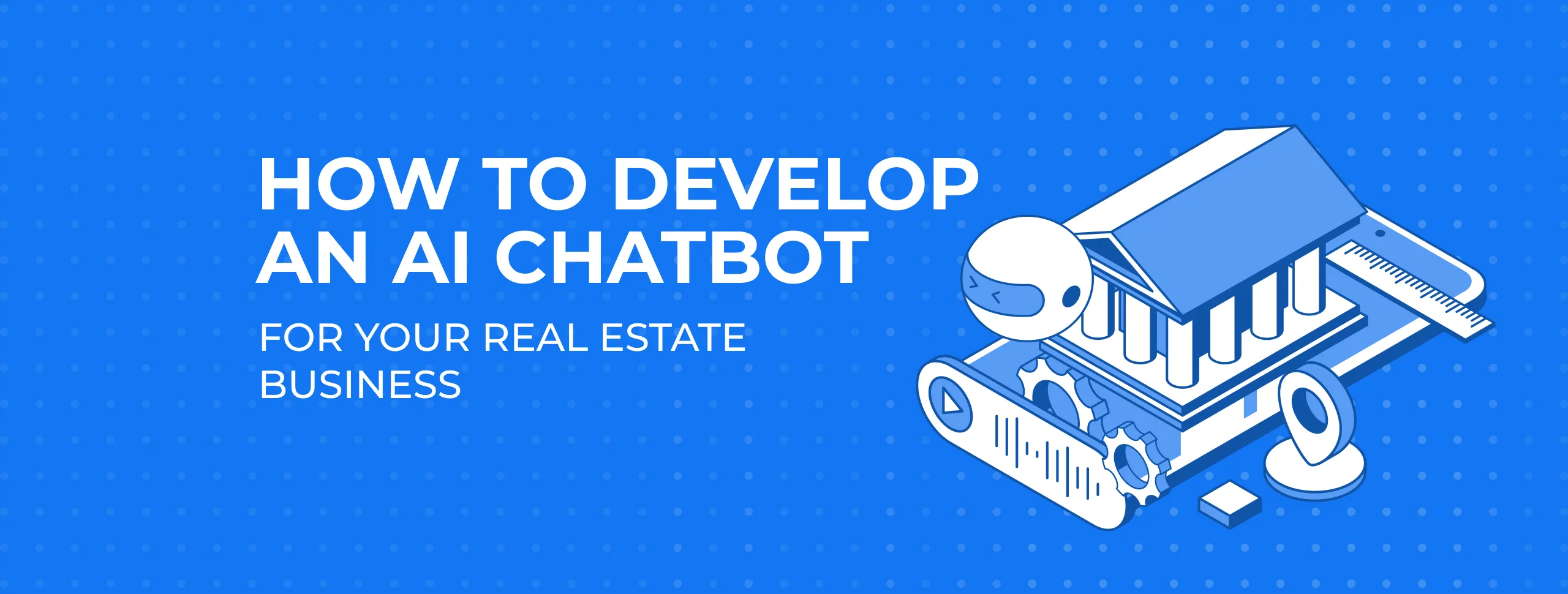
How to Develop an AI Chatbot for Your Real Estate Business

Table of contents
- What is an AI Chatbot for Real Estate?
- 5 Benefits of an AI Chatbot for Real Estate
- The Development Lifecycle of an AI Chatbot for Real Estate
- Summary: AI Chatbot for Real Estate
In the upcoming years, Artificial Intelligence (AI) will become a game-changer in the real estate industry. A dynamic and competitive sector, property management can certainly benefit from AI support that allows for automation, streamlined operations and better customer service.
There are many advancements in the AI field to be excited about when it comes to the real estate industry: from predictive analytics that allow you to anticipate future trends in the sector to smart buildings that use automation for better energy efficiency and virtual reality tours that allow tenants to view property remotely.
And while these services are still nascent, one AI tool is already making a significant impact in the industry: the AI-based chatbot.
The right AI chatbot for your real estate business can be much more than a tool that responds to simple client queries. It can help you generate high-quality leads, create a personalized experience for your existing clients, take over time-consuming repetitive tasks, and ultimately bring you a high return on investment (ROI).
In this article, we will share an in-depth overview of the benefits of AI chatbots for real estate and give you a detailed step-by-step guide on how you can build your own AI virtual assistant.
What is an AI Chatbot for Real Estate?
AI chatbots for real estate can handle routine tasks such as scheduling viewings, sharing property details, and following up with clients. In addition to automating time-consuming tasks, they can also assist you in more complex processes like property valuation, the verification of documents, and transaction tracking. A well-designed chatbot can help you improve your company’s operational efficiency and maximize profit.

Created with Dall-E.
5 Benefits of an AI Chatbot for Real Estate
The right AI chatbot can bring several key benefits to your real estate business:
1. An AI Chatbot is Available 24/7
As a real estate professional, you are well aware of how time-sensitive this industry is. What’s more, your clients are often most active outside standard business hours. An AI chatbot is available round-the-clock and can help you handle client communication even late at night or early in the morning.
2. It Leads to Improved Customer Service
AI chatbots automate responses to common inquiries, which allows them to give instant replies. This ensures that no client is left waiting, leading to better customer service. A robust AI chatbot solution can also provide additional services like sharing property details and other information, which can further enhance the customer experience.
It Can Help You Generate Leads
AI chatbots can engage with visitors on different platforms, including your website, social media channels, and listing sites. They can start conversations, understand user needs, and capture client details. AI chatbots can also collect contact information, qualify leads based on their interactions, and pass high-quality leads to your sales team. This provides your team with better customer insights and allows them to focus on high-intent leads and boost conversion rates.
It Boosts Efficiency
Chatbots are quite good at managing routine activities such as appointment scheduling, property detail dissemination, and client follow-ups. But in addition to that, they can also help you automate more intricate processes like property valuation, document verification, and transaction monitoring. This improves your business’s overall operational efficiency and frees up time for your employees to focus on more complex, revenue-generating activities.
It Allows for a Personalized Experience
AI chatbots can customize interactions based on user data and preferences, giving each client a personalized experience. By analyzing user behavior and past data, chatbots can suggest properties that match the client's needs and preferences. They can offer useful information like property details, neighborhood statistics, and market trends.
Additionally, AI chatbots can remember previous conversations, allowing them to continue from where they left off. This can help build a sense of familiarity and trust among clients.
.webp)
The Development Lifecycle of an AI Chatbot for Real Estate
The application development lifecycle involves six stages, each crucial for building a robust AI chatbot for real estate. Let’s take a more detailed look at each of them:
1. Discovery Phase
During the discovery phase, it's essential to define your chatbot's objectives through:
Competitor Analysis
Conduct thorough market research to understand the specific needs and pain points in the real estate industry that your chatbot will address. Analyze existing real estate chatbots to determine their features, strengths, and weaknesses. You can look at user reviews and feedback on competitor products to learn what works and what doesn't.
User Interviews
Talk to stakeholders, including real estate agents, property managers, potential users, and technical staff. Ask them about user needs, desired features, and any existing pain points they’ve noticed. Define specific use cases for your chatbot, such as scheduling property viewings, answering property-related queries, generating leads, and providing mortgage information. Prioritize these use cases based on their potential business impact and user demand.
User Journey Map
Create a user journey map to visualize the end-to-end experience of users interacting with your chatbot. Identify touchpoints, user emotions, and potential pain points throughout the journey. This will help in designing a user-centric chatbot experience.
Product Scoping
Create a detailed technical requirements document that outlines all the necessary features and performance criteria. Cover aspects like chatbot functionalities, data flow, user interactions, and security requirements.
Integration Report
Assess how your chatbot will integrate with existing systems such as CRM, property databases, and communication platforms. Document the integration points, required APIs, and data exchange protocols.
Product Release Plan
Develop a project plan with clear milestones, deliverables, and deadlines. Use project management tools like Jira to manage tasks and timelines efficiently. Define the roles and responsibilities of each team member involved in the project.
.webp)
2. Design Phase
The design phase focuses on creating a user-friendly and engaging chatbot interface.
Sketching
During the design stage, you should develop initial sketches of the chatbot interface, including conversation flows and user interactions. These sketches will help visualize how users will interact with the chatbot and what the main screens will look like.
You can use design tools like Balsamiq, Adobe XD, or Sketch to create your sketches.
Wireframing
Next, turn the sketches into wireframes. Include key features like property search, viewing schedules, and FAQ sections, clearly showing navigation paths and major user actions.
Before proceeding to the next stage, share the wireframes with stakeholders for feedback and make changes based on their input.
Prototyping
Once you’re happy with the wireframes, you can proceed to prototyping. You can develop a clickable prototype using tools like InVision or Figma.
After you conduct review sessions with stakeholders to gather feedback and make the necessary adjustments, you can proceed to the development stage.

3. Development Phase
With the design complete, the next step is transforming the model into a fully functional product. This is where programmers step in to implement all the necessary features. At this stage, programmers develop the first version of the chatbot, which has just enough functions to be usable, known as the MVP (Minimum Viable Product).
There are four crucial steps in the development phase:
Step 1: Set Up the Environment
First, you need to install the necessary libraries and frameworks that are essential for chatbot development.
Once you do that, you need to configure your development environment by setting up a code editor and version control, and creating a virtual environment to manage dependencies effectively.
Step 2: Build the Backend
To build the backend, begin by designing and implementing RESTful API endpoints that will serve as the communication interface for the chatbot. These endpoints are crucial for handling incoming user messages and sending appropriate replies.
Then, develop the core logic for processing user inputs. This includes parsing messages, maintaining session states, and defining the response generation mechanism. You can implement this logic by either using predefined rules or by generating dynamic content.
Step 3: Integrate Natural Language Processing (NLP)
To enhance the chatbot's ability to understand and process user inputs, integrate NLP tools such as NLTK, SpaCy, or external APIs like Dialogflow.
With the help of these tools, the chatbot can extract intents and entities from user messages, which is essential to understanding user queries. Collect and annotate relevant data to train your NLP models so that they can accurately recognize and respond to different intents and entities.
Step 4: Train the Chatbot
To train the chatbot, start by gathering comprehensive datasets, which can include sample conversations, FAQs, and other relevant texts.
Clean and preprocess the collected data to remove noise, handle missing values, and prepare it for training. This involves steps like tokenization, stemming, and other text preprocessing techniques.
Next, train the chatbot using either machine learning models such as long short-term memory (LSTM), Transformers, or recurrent neural networks (RNNs), or by implementing rule-based systems with conditional statements and regular expressions.
Finally, rigorously test the chatbot with various scenarios to ensure it responds accurately and appropriately. Create test cases covering different user intents and edge cases, and refine the model or rules based on the test results.
.webp)
4. Quality Assurance
Some software development agencies may skip extensive testing and proceed directly to the release phase. However, this will almost certainly compromise the quality of your real estate AI chatbot.
Effective testing should address up to 90% of potential issues. Addressing bugs before release is much easier than correcting them post-launch while dealing with unhappy customers.
5. Deployment
Once the development is complete, you can either publish the chatbot application to an app store or deploy it for use in a business’s operations (for web applications).
However, if you want your AI chatbot to be exceptional in meeting user needs, your work shouldn’t stop here.
6. Maintenance and Continuous Improvement
You should continue to refine the app, and enhance it when necessary by adding advanced features from the project's backlog. The best developers also provide ongoing technical support for any issues that may arise.

Created with Lexica.art. Source: Lexica.art
Summary: AI Chatbot for Real Estate
Developing an AI-based chatbot for your real estate business can significantly enhance your operations, improve customer service, and boost profits. By following a structured development process, you can create a powerful tool that meets your business needs and delivers a high return on investment.
When you’re ready to start developing your AI chatbot, contact us. Our team at Magora is ready to bring your idea to life and help you stay ahead in the competitive real estate market.





